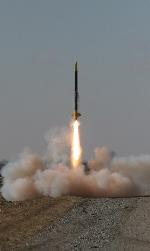Indiana Rocketry January 2012
January 2012
/ Ash Grove Site
2 flights, 4250 N-sec burned
Wind on the scheduled launch date forced a second pick-up launch the weekend after for the Purdue USLI team to get in a test. With perfect weather - sunny, clear, and temps in the 50s - I couldn't not fly a rocket or two.
Flight 1: Little John, BMW K700
The weather had finally calmed in January for the first flight of the LJ. Since I was trying a new deployment technique, I wanted to keep things low so I could get a good view of exactly what was happening during the sequence. The weapon of choice was a nice purple 1750 motor that Vic Barlow made for me as a Christmas present (thanks man!). I made up a thermite igniter to get things going quickly. Gus Piepenburg helped me load it onto his rail for the first flight of the morning; after a quick countdown, we were off to the races. The 1750 had no problem picking up the 23 lb airframe, and the boost was nice and straight. At apogee, the ARTS fired the first deployment charge, and things stabilized under the 30" drogue chute. Everything seemed to be working so far. At 1000 feet, the rocket fell through a cloud deck; while it invisible, the main charge fired, and the deployment bag/pilot cleared the nose cone. However, the pilot was a little too small to yank the bag from the cone, and so the chute remained stuck; the rocket fell to the ground with the benefit of only the drogue and the pilot, and landed sticking straight up in the mud, with no damage except to my pride. Oh well - at least it was just a test flight :)

others: on the pad | in flight
video
Flight 2: Little Dragon, PPL K900
When I woke up the morning of the launch, the weather was perfect enough that I decided it was a good day to do something I had been wanting to for a long time: stuff a 2550 into Little Dragon (going for a flame-to-rocket ratio of > 1). The white load had been sitting around for a loooong time (the result of a casting party a year earlier), but was pretty much ready to go; I quickly swapped forward closures to add a recovery eyebolt before loading the motor in the rocket and heading out to the field. I was the last one to go for the day; loading onto the pad was easy, and within a few minutes we were ready to go. Doug Jackson held my tracker for me while Gus Piepenburg pushed the button; the motor pressurized and the rocket vaulted from the pad, only to separate almost immediately, followed by a rather obvious motor failure. Mayhem was breaking loose as the electronics and recovery system tumbled down (the altimeter never armed) while the booster continued a flaming, twisting journey across the sky, eventually landing in the muddy field next door with a thud. Post-mortem indicated that, in my hasty forward closure swap, I had neglected to include the o-ring. DOH! Luckily, the 2550 is so long that the damage was confined to the anti-zipper coupler and some minor bubbled paint; a little fiberglass and epoxy and she will be as good as new.

others: uh oh | flaming loops
video

